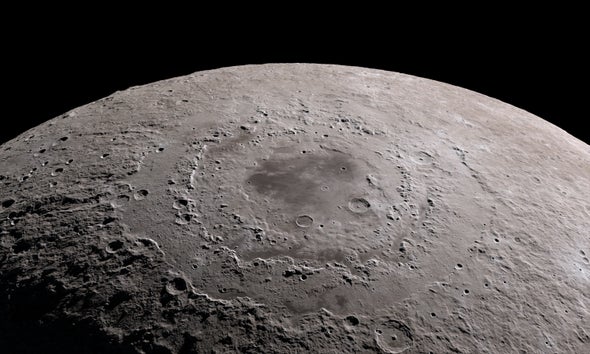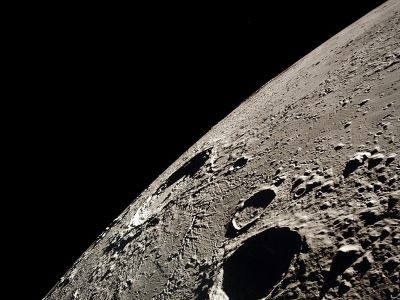Booming exploration and commercial activity could ruin the quiet, astronomy-friendly environment of the lunar far side

The far side of the Moon is protected from radio-frequency interference from Earth. Credit: NASA’s Scientific Visualization Studio
For radioastronomers, the far side of the Moon could be the last unspoilt refuge in the Solar System. Planet Earth — and all the human-made electromagnetic noise it spews out into space — stays permanently below the horizon, so that any radio observatories positioned there would be free to observe the cosmos without interference.
But an upcoming boom in lunar exploration could put that at risk. In the next ten years or so, the Moon will be the target of hundreds of orbiters and landers, each of which could create radio noise. Researchers voiced their concerns last month at a conference called Astronomy from the Moon: The Next Decades, which took place at the Royal Society in London.
“This is probably the most radio-quiet place in the Solar System, and we need to preserve that,” said Marc Klein Wolt, an astronomer at Radboud University Nijmegen in the Netherlands.
“Will the far side remain dark? You should already be nervous that I’m asking the question,” Joseph Lazio, a researcher at NASA’s Jet Propulsion Laboratory in Pasadena, California, told the conference.
QUIET ZONE
The lunar far side has enormous potential for many fields, but it holds unique promise for cosmology. Astronomers have mapped the sky using much of the spectrum of electromagnetic waves, from microwaves to visible light and γ-rays. But cosmic radio waves at frequencies below about 100 megahertz are extremely challenging to measure from Earth, because of the planet’s noise. And anything below 30 megahertz is completely off-limits because it is absorbed in the ionosphere — the zone where Earth’s atmosphere meets space. These low-frequency waves, however, carry a treasure trove of information about the first billion years or so of the Universe’s history.
The lunar far side is protected from radio emissions from Earth, and with almost no atmosphere and long, cold nights, it offers a nearly ideal spot from which to explore these epochs.
If all goes according to plan, a small US lander called the Lunar Surface Electromagnetic Experiment (LuSee) Night in 2026 will be the first dedicated cosmology mission to take advantage of those conditions — and it is being designed with that goal in mind. (Chang’e-4, the historic Chinese mission that landed on the far side in 2019, carried a simple radioastronomy antenna. But the mission was not optimized for cosmological observations, so the experiment was marred by radio-frequency interference from the lander itself.)
With funding from both NASA and the US Department of Energy, LuSee-Night will be carried to the far side by a private contractor as part of NASA’s nascent Commercial Lunar Payload Services programme. Its four 3-metre-long antennas, arranged in a cross shape, will attempt to measure the ‘cosmic dawn’, a feature thought to be detectable in the radio spectrum that would reveal the appearance of the Universe’s very first stars.

NOISE LIMITATION
Even from the peaceful solitude of the lunar far side, however, LuSee’s cosmic-dawn measurement will be a challenge: the early-Universe signature is 100,000 times weaker than the noise produced by the Galaxy in the same range of frequencies. It will be crucial to limit noise from the spacecraft itself. “The only way to do it is to turn off the lander completely” and pack enough batteries to last the radio receiver through the two-week-long nights, says Stuart Bale, an astrophysicist at the University of California (UC), Berkeley, who is the mission’s principal investigator for NASA. The receiver’s electronics, including the clocks that keep computers running, must be designed to ‘fence’ any emissions to a limited part of the spectrum, Bale says. “We require that all oscillators operate at known frequencies, and with certified frequency stability.” A known, predictable source of noise is easier for experimenters to remove during data processing.
These are relatively simple precautions that all lunar missions could take, including commercial ones, says Bale. If spacecraft are designed to contain any radio-frequency interference, it could greatly reduce the chances of harming future scientific experiments.
Melanie Johnston-Hollitt, former director of the Murchison Widefield Array radio observatory in Western Australia, agrees. At Murchison, which is to be the Australian site of the giant Square Kilometre Array radio telescope, she helped to establish what is probably the world’s largest radio-quiet zone, at more than 500 kilometres across.
Permits are required to carry electronic devices into the site, and “all equipment you take into that area goes through an additional electromagnetic testing process”, to check for unwanted radio emissions, says Johnston-Hollitt, currently a radioastronomer at Curtin University in Perth, Australia. “I can tell you with confidence that you can do that with a cubesat,” she says, referring to the tiny satellites that researchers fear could swarm around the Moon, creating a source of noise.
Even so, “to suppress interference to the level necessary to do precision radioastronomy is incredibly difficult”, says astronomer Andrew Siemion, who leads the Breakthrough Listen search for extraterrestrial intelligence project at UC Berkeley. That work involves looking for signals across a broad range of radio waves — including the gigahertz frequencies at which satellites communicate.

LUNAR ECONOMY
Astronomers face an uphill struggle. The same technological advances that promise to make the Moon more accessible for their experiments will also make the environment more crowded. More than 250 Moon missions are expected over the coming decade from the space agencies of the United States, Europe, Russia, South Korea, China, Japan, India, Canada and the United Arab Emirates — as well as a host of private companies. That will add up to a US$100-billion ‘lunar economy’, according to Northern Sky Research, a consulting firm in Cambridge, Massachusetts. There are also plans to install a lunar satellite navigation system, which could be a source of noise.
Alanna Krolikowski, a political scientist at Missouri University of Science and Technology in Rolla, thinks that researchers should push for international treaties to protect the Moon. “There is now widespread recognition that we need governance for this forthcoming lunar renaissance,” she told last month’s conference.
The Artemis Accords, an international agreement led by NASA, attempts to provide some guidance to help the agencies involved avoid disrupting each other’s missions. But it is designed mainly to serve the needs of its signatory countries; a better way to regulate the Moon could be to have rules drafted by the United Nations Committee on the Peaceful Uses of Outer Space, Krolikowski said. “The window in which to do that is small — and shrinking.”

source: https://www.scientificamerican.com/







